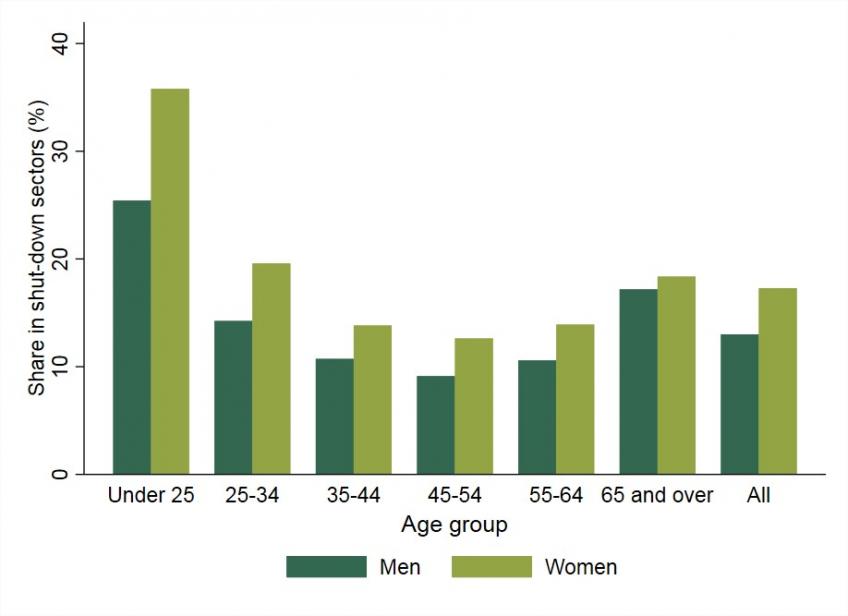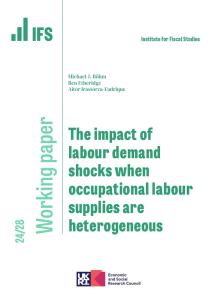The lockdown in response to the Covid-19 pandemic has effectively shut down a number of sectors. Restaurants, shops and leisure facilities have been ordered to close, air travel has halted, and public transport has been greatly reduced.
Our analysis shows:
- The lockdown will hit young workers the hardest. Employees aged under 25 were about two and a half times as likely to work in a sector that is now shut down as other employees. On the eve of the crisis sectors that are shut down as a result of social distancing measures employed nearly a third (30%) of all employees under the age of 25 (25% of young men and 36% of young women). This compares to just one in eight (13%) of workers aged 25 and over. (These figures all exclude full-time students with part-time jobs).
- Low earners are seven times as likely as high earners to have worked in a sector that is now shut down. Fully one third of employees in the bottom tenth of the earnings distribution work in shut down sectors versus just 5% of those in the top 10%.
- Women were about one third more likely to work in a sector that is now shut down than men: one in six (17% of) female employees were in such sectors, compared to one in seven (13% of) male employees.
- One mitigating factor is that the majority of the affected younger workers and lower earners live with parents or others whose earnings are likely to be less affected, so many may suffer smaller hits to their living standards than otherwise.
Who works in the most negatively affected sectors?
We estimate that, on the eve of the crisis, around one in seven (15% of) employees in the UK worked in a sector that has largely or entirely shut down during the Covid-19 lockdown. These include non-food retail, restaurants and hotels, passenger transport, personal services and arts and leisure services (the full list of included sectors is given in the endnotes).
Because women disproportionately work in retail and hospitality, Covid-19 is likely to have a bigger effect on their earnings. Overall, on the eve of the crisis women were about one third more likely to work in a sector that is now shut down than men: one in six (17% of) female employees were in such sectors, compared to one in seven (13% of) male employees.
There is an even larger disparity by age. The lockdown is likely to hit younger workers the hardest, as shown in Figure 1 below. On the eve of the crisis, employees aged under 25 were about two and a half times as likely to work in a sector that is now shut down as other employees. Sectors that are shut down as a result of social distancing measures employed nearly a third (30%) of all employees under the age of 25 (25% of young men and 36% of young women). This compares to just one in eight (13% of) workers aged 25 and over. These figures all exclude workers who are in full-time education: we are not talking, for example, about students who had part-time jobs in bars and restaurants.
Figure 1. Share of employees in shut-down sectors, by gender and age

Source: Quarterly Labour Force Survey Q1-Q4 2019, Waves 1 and 5 only.
Notes: Employees only. Excludes workers in full-time education.
The largest disparity of all is simply by earnings level. Figure 2 shows the share of workers directly affected by the lockdown across ten equally-sized bins (deciles) of individual weekly earnings. Those with the lowest earnings are about seven times as likely to work in shut-down sectors as those with the highest earnings. 34% of employees in the bottom tenth of the earnings distribution work in sectors directly affected by the lockdown, compared to just 5% of those in the top tenth.
Figure 2. Share of employees in shut-down sectors, by individual earnings

Source: Quarterly Labour Force Survey Q1-Q4 2019, Waves 1 and 5 only.
Notes: Employees only. Excludes workers in full-time education.
These results chime with a recent survey which found that younger workers and low earners were more likely to have lost their jobs or seen their earnings fall by the end of March as a result of Covid-19.
Other household members
Some workers in shut-down sectors will live with partners or other household members who are not directly affected by the lockdown, which may cushion them from falls in their own earnings. This is particularly the case for young people whose jobs are most at risk, since over half (61%) of under-25s who work in shut-down sectors live with their parents. Figure 3 shows that whilst nearly a third of employees in this age group work in sectors that are directly affected by the lockdown, only 16% of their total household earnings are drawn from these sectors. Nevertheless, this is still a larger share of household earnings than the respective figure for any other age group.
Figure 3. Exposure to sector shut-downs, by age

Source: Quarterly Labour Force Survey Q1-Q4 2019, Waves 1 and 5 only.
Notes: Employees only. Excludes workers in full-time education and those with self-employed household members (for whom earnings are not recorded).
Similarly, Figure 4 shows that whilst 34% of employees in the bottom tenth of the earnings distribution work in shut-down sectors, only 16% of their total household earnings comes from these sectors. This is because more than half (53%) of the lowest earners who work in a shut-down sector have a partner or other household member (usually a parent) who works in an industry that is not directly affected by Covid-19, and who typically have higher earnings. Again though, even on the latter measure the lowest earners are more exposed to the direct impacts of sectors shutting down than higher earners.
Figure 4. Exposure to sector shutdowns, by earnings

Source: Quarterly Labour Force Survey Q1-Q4 2019, Waves 1 and 5 only.
Notes: Employees only. Excludes workers in full-time education and those with self-employed household members (for whom earnings are not recorded).
Notes
The list of sectors classed as being directly affected by the lockdown are as follows (4-digit SIC codes in brackets): Non-food, non-pharmaceutical retail (4719, 4730-4772, 4776-4799); passenger transport (4910, 4931-4939, 5010, 5030, 5110); accommodation and food (5510-5630); travel (7911-7990); childcare (8510, 8891); arts and leisure (9001-9329 except ‘artistic creation’ 9003); personal care (9601-9609 except ‘funeral and related activities’ 9603); domestic services (9700).












